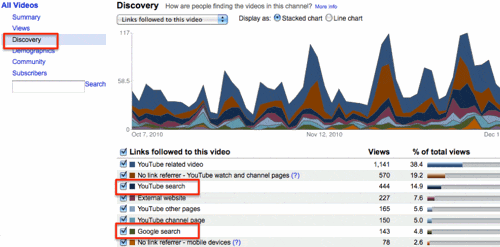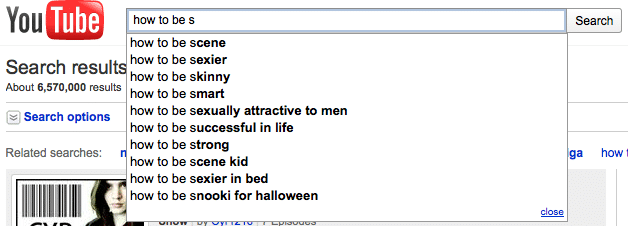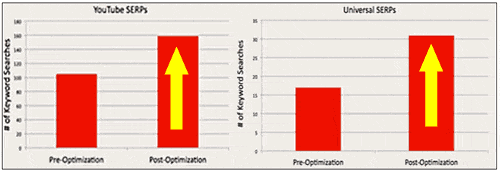
Most reasonable marketers probably pine to see their YouTube videos rank, in Google and Bing’s organic Universal SERPs, for important keyword searches. While the exact ranking algorithms are super secret hot sauce, follow YouTube tagging best-practices to get videos ranked in Google, Bing & YouTube itself.
This post is a case study on the process we take to identify Universal SERP opportunities, research keyword tags, effects on rankings after tagging, and crucial reports to document ranking KPI results.
Learning From the Past
The assignment is to retag our YouTube videos.
The KPI is higher organic prominence in YouTube SERPs and more Universal search results in Google and Bing.
First lets’ have a look at what core keywords currently drive views. You can find this information in the “Discovery” tab of YouTube Insights. Identify which YouTube searches currently get the job done, as well as what Universal search terms you are ranking for and benefiting from. It’s important that we don’t hinder performance by removing existing successful keywords from the tagging structure. That would be wrong and a waste of perfectly good success. Instead, think about how we can support and amplify what already works well, in the optimization efforts.
Mine the Suggest Box
The next piece is guerrilla keyword research. One of the best YouTube keyword research tools available is YouTube’s own Ajax search suggest box. Although no search volume or visible weighting is associated with suggestions with this method, we know these suggestions are influenced and ranked by user search patterns and frequency. I often find this approach will lead to longer tail permutations I may have overlooked otherwise.
There are a couple of different ways to pull down the YouTube Ajax suggest results. ScrapeBox is a paid tool that quickly harvests suggest data from YouTube, Bing and Google and has a whole range of other applications. Whatever the method, the real art is to…
Identify the intersection of keyword inventory and Universal search opportunities across multiple engines for reasonably attainable key phrases.
YouTube Ranking Report
Prior to making optimization changes let’s examine current performance in YouTube SERPs as a baseline. AIMCLEAR‘s YouTube ranking report (shown below) illustrates where specific videos rank for keywords and associated YouTube Ajax suggestions. We use the report to track YouTube internal SEO video tagging KPIs. Putting this together requires crawling YouTube SERPs for the keywords you’ve identified and logging video titles, URLs and the ranking position.
Universal Ranking and Correlation Report
Now correlate internal YouTube organic search results to Google and Bing Universal SERPs for keywords and associated YouTube Ajax suggestions. The importance of this report is to capture successes where they are being had in Universal searches prior to making optimization changes as a baseline to measure optimization against. All data was gathered through unpersonalized search and logged out of Google accounts.
What Happens
Two weeks after the optimization changes were put in place, run the ranking reports to measure changes. The red bar graphs below illustrate common results across 25-30 videos. Your results will be dependent on how well the videos were tagged in the first place and competitiveness of the KW space.
The mock results illustrated in the red bar graph below are results of a composite case study. We had 25-30 poorly tagged and mature YouTube videos to work with, in lightly to slightly competitive keyword space. Look for an 80+ % increase in the number of videos ranking in Universal search results and a 50+ % of lift in the number of search terms and videos ranking in YouTube search results.
Happy Tagging
When you get down to it, this is about assessing opportunities in both the long and short tail, finding the intersection of search inventory across search engines, supporting video with primary ranking factors, and measuring changes against set baselines. This does not mean that attention in itself to these things will guarantee success, since there is no catch all formula for all verticals. Every space is different and some have higher barriers to entry than others. The process outlined in this post should give readers baseline tools needed to retag videos and measure performance, in the various SERPs. Happy tagging!













